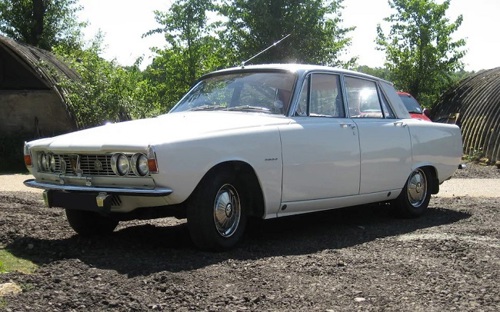THE SHOCK OF THE NEW
06 January 2025
Imagine you were a 1948 London Motor Show visitor and determined to derive the most from your ten-shilling early admission ticket. One stand in particular is attracting a huge amount of attention. The London Evening Standard reported: “women visitors were everywhere - leaning over rails, studying moving chassis and engine parts, stepping in and out of cars, and asking severely practical questions”.

These star attractions were, of course, the Minor MM Saloon and Tourer. By the end of production, many Britons viewed them as about as radical as The Archers, but in 1948, the first post-war small Morris was a genuine shock. Not only did it bear no resemblance to its Eight predecessor, but its only recognisable features were its badges and 918cc side-valve engine. The specification included rack & pinion steering and independent front suspension, while its bodywork made the rival Ford Anglia E494A appear almost prehistoric. Autocar raved:
“Now and again it happens that circumstances bring a person suddenly into prominence, and he or she instantly becomes a favourite in the public affections. Something similar occurs sometimes with new cars, and it is likely to happen to the new Morris Minor.”
The Nuffield Group (Morris, MG, Riley and Wolseley) was far from the only UK vehicle car manufacturer to introduce a model that marked an apparent change in direction. In 1965, the Ford Transit amazed fleet operators and competitors alike, many of whom predicted an updated version of the outgoing Thames 400E. However, Ford invested £10 million in Project Redcap, which aimed to be the first British-built light commercial vehicle with car-like comfort.
Ford also tested prototypes on the (still speed-limit-free) M1 as befitting a van for “The Motorway Age”. Your friendly local dealer could also tell you about the all-synchromesh transmission V4 engine. Meanwhile, Commerical Motor thought: “Handling is first class. The light and accurate steering gear makes it possible to place the machine exactly where you want it without any undue effort”.
Rover surprised its customers several times after the Second World War. The P4’s reputation for solid comfort and gravitas overlooks the fact that some marque devotees were astounded on its launch in 1949. The 2.1-litre power plant may have been familiar but, as Brian Sewell put it, the P4 seemed:
“the most brilliant, the most forward-looking car of its day, the first full-width, streamlined Rover, all corners rounded, all contours smooth, sans running boards, sans separate headlamps, the great Cyclops eye of a third headlamp set in the prow that had no conventional radiator grille.”
Nine years later, the P5 was the first chassis-less Rover, and its David Bache coachwork looked utterly different from the Humber Super Snipe. In 1963, when the P4 was now comfortably middle-aged, the P6 made its bow, causing pipes to fall from mouths in amazement. Bache aimed for “a simple classical form, devoid of all superfluous ornament”, and the body consisted of non-stressed panels bolted to a unit frame.
If that were not a sufficient shock, there was a new 1,978cc four-cylinder overhead-camshaft engine, all-disc brakes and double wishbones at the front, with top links 90 degrees to their lower counterparts. At the rear, the P6 employed a De Dion sliding tube with fixed length driveshafts. Inside were four leather-clad bucket seats and a fashionable strip speedometer. Motor Sport wrote, “No longer do these fine cars necessarily associate themselves with elderly drivers in Panama hats”.
As with its predecessors, the P6 came to be regarded as unthreateningly establishment, which would explain the surprise when Rover unveiled its SD1 replacement in 1976. Bache aimed to create a five-door supercar with Ferrari 365GTB/4 Daytona overtones and believed “The word ‘elegant’ describes the styling philosophy behind the new Rover”.
And there are many other examples of car makers surprising their traditional customer base. The stories of the 1959 Mini and 1962 ADO16 from the British Motor Corporation are well-known but just think of the impact the Austin FX4 made on London taxi drivers in 1958. Gone was the FX3’s luggage platform and opening windshield, as well as the fact it was the capital’s first taxi with automatic transmission as standard.
In September that same year, the Austin A40 became the first BMC car with styling by Pininfarina. BMC claimed it ‘presented ‘a glimpse into the future of small car styling’ and as I wrote in Classic & Sports Car:
“ ‘Italian design’ was becoming synonymous with the ‘Affluent Society’. The original Teddy Boys were either mutating into ‘Ton-Up Boys’ or retreating to the provinces, tailors offered three-button suits, and ‘Modernists’ donned their shades for a trip to the grocers. A Farina buyer may have preferred a nice cup of tea to an espresso in the Heaven & Hell coffee bar – but nor were they entirely hidebound by tradition.”
The Farina-styled BMC car made its bow in December of 1958, and the 15/60’s tail fins confounded many a Wolseley owner. The Corporation may have claimed the bodywork was “as modern as the hour”, but such design tropes seemed on par with Richard Dimbleby singing rock and roll on ITV's Oh Boy! Nor should it be forgotten just how startling the ‘Wedge’, the last car to wear the Wolseley badge appeared in 1975. Or how the Rover 3500 SD1 the following year astounded P6 owners who had forgotten the controversy of 1963.
After all, a truly interesting car aims to create its own tradition.
With thanks to Nick Dunning of The Rover Sports Register for his time and permission to use the images in this blog.
